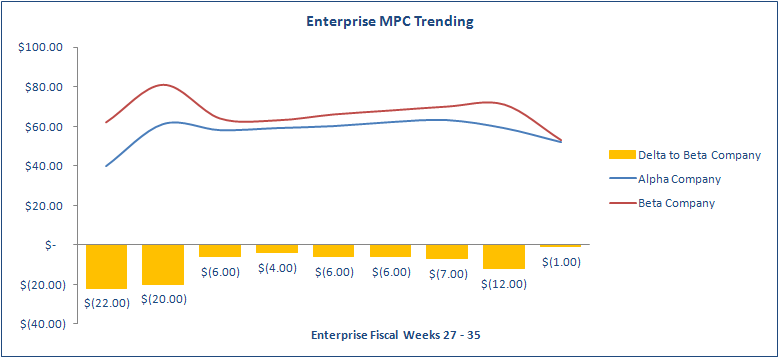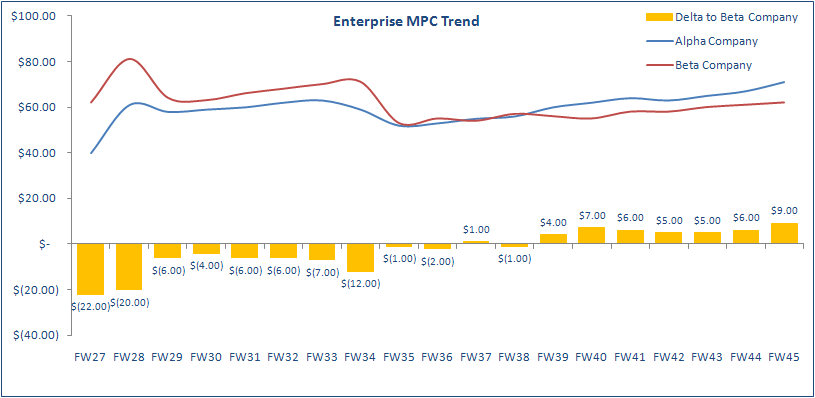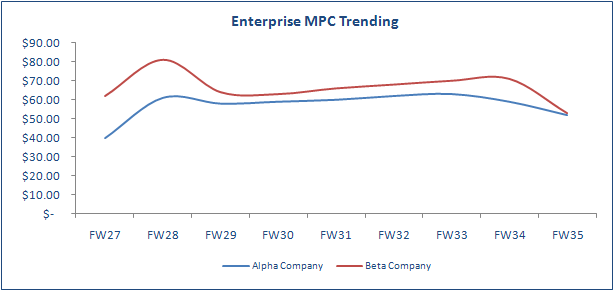Six Sigma DMAIC at Work – A Case Study…
DMAIC (duh-may-ick) is an abbreviation for a method used in Six Sigma. It stands for the 5 distinct phases it goes through: Define (the problem), Measure (aspects of the problem), Analyze (the information flow), Improve and Control (the process). Let’s use a case study example and analyze each phase…
A US-based employer which sells computers and other software and peripherals contracted two outsource companies: Alpha Company and Beta Company to do the selling. For almost two years these two outsourced companies have been in a tight competition when in comes to several metrics. The first four quarters it has always been the Alpha Company who out performed Beta Company. Beta Company though have been out performed made some adjustments and proved indeed that they can surpass the performance of Alpha Company.
Alpha Company has always owned the Close Rate metric, which means they sell more boxes than the Beta Company. Beta Company on the other hand, owned the MPC metric. This means that every unit sold is of higher revenue and margin. This gives the employer better profit. On a business standpoint, selling less units but of higher revenue and margin is better than selling more units of low revenue and sometimes no margin at all.
In one of the quarterly business reviews, the employer expressed its intention to just maintain one outsourced contract by the end of the fiscal year. With this position, the Director of Alpha Company instructed its Operation and BPI Heads to device a plan that will improve the company’s MPC. A general meeting was scheduled; trained and skilled people were called upon for a specific project. The goal of the project is to improve revenue and margin related metrics while at the same time maintain close rate performance.
The performance of the company is measured in several ways. Since the program has a sales orientation, the king of all metrics is Close Rate. This computed by dividing the total number of sales over the total number of received calls. Target for this metric is 35.00%. Some other metrics that are also important on a sales program are:
- TMU (Total Margin per Unit) computed by dividing the total margin of units sold over total number of sold units. Target for this is $126.00
- TRU (Total Revenue per Unit) computed by dividing the total revenue of units sold over total number of sold units. Target for this is $997.00
- MPC (Margin per Call) computed by dividing the total number of margin per call over total number of received calls. Target for this is $21.00
- SRU (Service Revenue per Unit) computed by dividing the total number of service revenue sold over total number of sold units. Target for this is $107.00
- SPRU (Software and Peripherals Revenue per Unit) computed by dividing the total number of software and peripherals revenue sold over total number of sold units. Target for this is $65.00
People who are tasked to do the project have been identified. Their roles and responsibilities were clearly and completely stated. Using the DMAIC model of Six Sigma a assignment called MPC Project was created. Some details of the project are narrated below.
DEFINE PHASE
Problem statement: From FW27-FW35, Alpha Company is trending lower than Beta Company on MPC.
Problem Scope:
- To identify drivers of low MPC performance
- To reduce the MPC performance gap/delta between Alpha Company and Beta company
MEASURE PHASE

- MPC trending shows that Beta Company performs better than Alpha company from FW27 – FW35 (10 consecutive weeks)
- Average delta of Beta Company over Alpha Company is $9.33
ANALYZE PHASE
Major root causes for MPC non-performance:
- Low TMU scores
- Agents are not shifting-the-mix for every sales call (priority is to close more boxes than adding value to the boxes sold)
- Low SRU and SPRU scores due to failure to position or offer services
- Proactive discounting.
- Inconsistencies on Close Rate performance
- Agents have difficulties/challenges in overcoming customer’s objections when positioning a solution package, service, or any up-sell item
- Absence of a structured callback process
- High variation on MPC performance between top performers, mid, and bottom performers
- Performance is not being tracked real-time
- Bottom performers receive the most number of calls
- Challenges on conducting trainings due to heavy call volume
IMPROVE PHASE
MPC Action Registry
- Real-time performance management (FW37)
- Change priority skilling based on weekly/daily performance of agents; top performers to get the calls first
- Owned by the Operations team
- Increasing SRU (FW37)
- Intensified road shows
- Owned by Sales Coaches and Operations team
- Road shows and presentation done at the team level
- Focus is to drive awareness of agents regarding the current state: running statistics / enterprise competition; providing solutions to properly shift-the-mix / close the sale
- Increasing SPRU (FW38)
- Creation of effective positioning spiels
- Owned by Sales Coaches and Training Team
- Provide effective positioning scripts with ready rebuttal spiels
- Close loop monitoring process on Policies, Procedures, and Customer Handling
- Owned by the Quality Team
- Focus is to audit Customer Handling behaviors and to establish a CMPD (Consequence Management Process Development) on Customer Handling non-compliance
- Improve sales skills (FW39)
- Effective sales management and leadership workshop for Team Leaders and Coaches
- Owned by the Training Team
- Team Leaders and Sales Coaches underwent training on negotiation skills and objection handling
- Monthly Full Cycle Performance Management (FCPM)
- Owned by Operations Team
- Changed quarterly FCPM to monthly review
- Focus is on Bottom Quartile and Mid-rank agents. On the later part top performers were included and FCPM became progressive (monthly review fro top; bi-weekly for mid; weekly review for bottom performers)
- Outlier Management (FW39)
- Outlier Management on several metrics such as CR , TMU, and MPC
- Owned by Sales Coaches
- Focus is on mid-rank agents
- System Mix Reporting and Up-sell Mix Reporting
- Bi-weekly reporting which started FW40
- Reports contain enterprise and team trending on system mix and up-sells which provided deep dive analysis on gaps on financial metrics impacting MPC, TMU, SRU, and SPRU
- Provided recommendations to address the gaps and served as basis for contests/hypes
- BPI (Business Process Implementations) audits on Black Friday and Cyber Monday deals
- Focus on behaviors affecting financials
- Provided recommendations to address opportunities
- Other recommendations adapted by Operations
- Scorecard improvement (computed for realistic goals)
- Screensaver on agents PCs – reflects goals, updates, and recognizes top performers
- Assigning stretch goals to financial metrics
- CMPD on Customer Handling
CONTROL PHASE

- Control Point: Applying Consequence Management to Team Leaders to reinforce audit and coaching compliance every week
- Alpha Company was able to surpass Beta Company’s MPC performance from FW37 and FW45
- FW37 was the start of the real-time Performance Management; Road shows; FCPM
- FW39 was the start of Leadership Workshop on Effective Sales Management training, System Mix and Up-Sell Mix Reporting, and Outlier Management
- FW41 Contest on MPC was launched
Since Margin per Call was the base metric of measuring margins and revenue per unit, significant increase was also observed on TMU, TRU, SRU and SPRU. Full Cycle Performance Management is still observed, priority is on bottom performers. Mentoring sessions are also conducted by top performers to their buddy bottom performer. Additional incentives are given to top performers. Agents are now confident in doing the system-mix and the up-sell mix.
As of this writing the program is still operating and delivering better scores and higher revenue for the employer.

